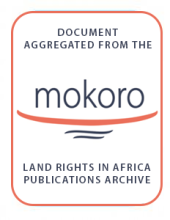Land Library Search
Through our robust search engine, you can search for any item of the over 73,000 highly curated resources in the Land Library.
If you would like to find an overview of what is possible, feel free to peruse the Search Guide.
/ library resources
Showing items 1 through 9 of 16.Looks at the dynamics of environmental displacement;land rights and conflict in the aftermath of the Cyclone Idai in Mozambique in March 2019;and at the role of international and national legal frameworks in addressing land-related problems caused by this displacement.
For more than five years;Ardhi Yetu Programme through its partners (HAKIARDHI;Tanzania Natural Resources Forum (TNRF);and PAICODEO) has been working with communities to advocate for land rights;gender equality and climate change adaptation.
In many rural areas across sub-Saharan Africa lack of tenure security for women has been exacerbated by rising commercial pressure on land;further aggravated by climate change;urbanisation and population growth.
Over the last two decades, 200 million people across the world have been lifted out of hunger.
A brief on the need to secure land rights for the world’s pastoralists, who manage rangelands that cover a quarter of the world’s land surface but have few advocates.
The rising conflicts between farmers and pastoralists threaten Nigeria’s food security, economic stability and ecological balance.
A call to action including: securing women’s rights to land and natural resources, including within communities; ensuring women’s meaningful participation in decision-making and dispute resolution related to access, use, control, and management of land and natural resources; identifying and suppo
East–Southeast Asia is currently one of the fastest urbanizing regions in the world, with countries such as China climbing from 20 to 50% urbanized in just a few decades. By 2050, these countries are projected to add 1 billion people, with 90% of that growth occurring in cities.
Report brings together the multiple legal strands that weave together and form the context of farmland investments and water rights.


